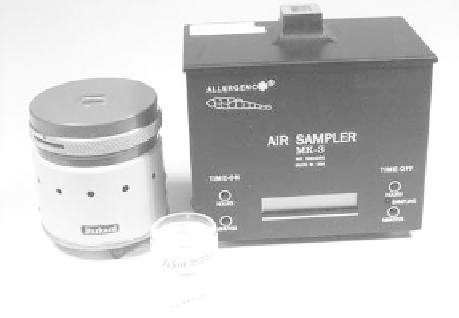Environmental Engineering Reference
In-Depth Information
Figure 9.9
Total mold spore/particle sampling devices.
and use of culturable/viable sampling methods and their amenability to
colony and organism identification.
In commercially available total spore and particle sampling devices, air
is drawn through a tapered slit at relatively high velocities. Particles are
inertially collected on a silicon grease- or adhesive-covered microscope
slide. After staining and slide preparation, mold spores and hyphal frag-
ments are enumerated at 1000
(oil immersion) magnification. Mold types
can often be identified to genera (but not to species, as is the case with
culturable/viable methods). Concentrations are usually based on a count
of 5% of the deposition area and expressed as spores or structures per cubic
meter (S/m
3
).
There are three impaction-type total mold spore/particle sampling
devices commercially available. All three instruments draw particles through
a tapered slitted orifice onto a greased impaction surface. Two are instru-
ments with integrated pumps; the third, a sampling cassette. In the last case,
particles are impacted on a greased microscope cover slip which is mounted
on a slide and counted at 400 to 600
×
magnification. Its performance in
providing accurate counts appears to be considerably less than devices with
integrated pumps. The Burkard spore sampler, cassette sampler, and Aller-
genco spore sampler are pictured in
Figure 9.9
.
Not pictured here is a relatively new commercially available particle
sampling device (button sampler) which can be used as a total mold spore
sampler. It collects particles, mold spores, bacterial cells, etc. on a filter
surface after passing through a porous cover which is designed to collect
particles with maximum efficiency. Sample counts are made from the surface
of light-transmitting filter surfaces. The button sampler is reported to have
higher collection efficiencies for mold spores (such as
Cladosporium
clado-
sporoides
) which have small aerodynamic diameters (
×
m). The nominal
cutoff diameter for impaction samplers such as the Burkard and Allergenco
is reported to be 2.5
≤
2
µ
µ
m.

